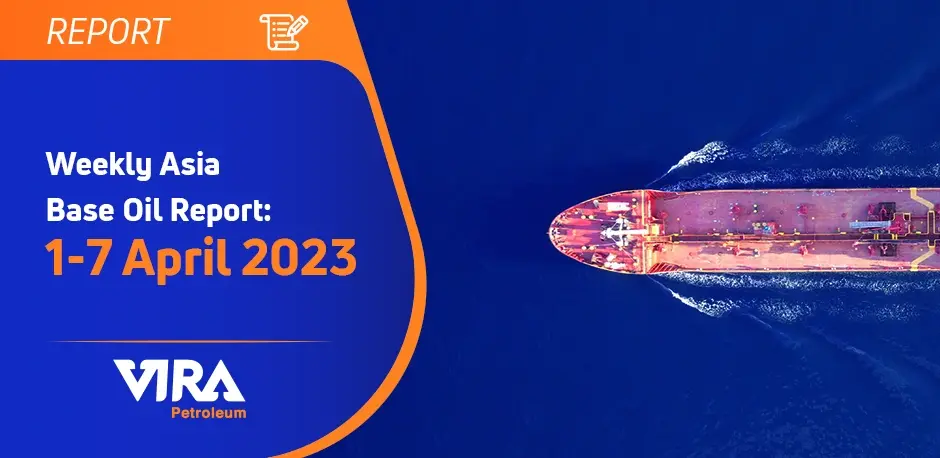The demand for base oils appears to have stagnated, with numerous purchasers refraining from procuring additional volumes due to the unclear fundamentals. However, the recent surge in crude oil and feedstock prices has mitigated some of the downward pressure on spot base oil values, which was previously caused by the lackluster demand in countries such as China. Furthermore, upcoming plant turnarounds in Asia, coupled with the potential tightening of supply, have also contributed to the rise in prices. As a result, buyers may feel compelled to secure products shortly.
Base Oil Trends In China
Despite disappointing buying interest for imports in China, other regions are showing positive signs. In Southeast Asia and India, demand for base oil has picked up, leading to the conclusion of several cargoes from source countries like Singapore and Thailand. The reason for the decrease in Chinese demand for imports is uncertain, but some suggest it may be due to a weaker-than-expected economic recovery following the sudden surge in COVID-19 infections. This situation has led to reduced demand from the industrial and marine lubricant sectors. Moreover, economic uncertainties and inflation are also affecting consumer sentiment globally, potentially contributing to lower interest in Chinese manufactured goods. As a result, it is important to monitor regional trends and adapt strategies accordingly to maximize growth opportunities in the global base oil market.
Order : Recycled Base Oil
The decrease in buying interest for base oil imports in China can be attributed to various factors. Some analysts believe that the growing domestic supply of base oil contributed to this trend. In 2019, several new plants commenced operations and were running at full capacity. Additionally, a new API Group II and Group III plant met specifications in January, adding to the already abundant supply of base oil. However, some plants have had to operate at reduced rates or shut down temporarily to prevent oversupply conditions. As a result, the demand for imported base oils declined. Even the sole Taiwanese Group II producer, which shipped large quantities to China in March, is now exploring opportunities in other countries due to the declining demand.
Base Oil Trends In South Korea
South Korean base oil producers have been expanding their customer base by concluding more business in Southeast Asia and the Americas, while reducing their business with China. However, upcoming plant turnarounds are expected to impact the availability of South Korean base stocks in the market. For instance, a major South Korean producer of Group II and Group III base oils is planning to shut down its base oil unit for maintenance for around 45 days in mid-May. This has prompted the company to build up its inventories to meet the demand during the outage. These turnarounds may result in a temporary reduction in the supply of base oils, leading to higher prices and tighter market conditions.
Base Oil Trends In Southeast Asia
The demand for Group I cargoes in Southeast Asia remained high, and there were several expected shipments within and outside the region. Although bright stock prices were under downward pressure, other Group I grades remained in strong demand in countries like India, especially since imports from Iran were unavailable. In Thailand, a prompt shipment of 1,000 to the 3,000-ton cargo was quoted from Rayong or Sri Racha to Mundra, India. Sri Racha also had a 2,000-ton parcel scheduled for lifting to West Coast India in mid-April, and a second lot of 1,500 tons was set for shipment from Sri Racha to Chennai or Chittagong, Bangladesh, between April 10 and April 20. The high demand for Group I cargoes was expected to continue due to the limited supply and the ongoing demand from the downstream segments like industrial and marine lubricants.
Order: Rubber Process Oil
Base Oil Trends In India
The base oil market in India has witnessed an uptick in demand in the past two weeks, which has resulted in a surge in interest for imports from Asia, the Middle East, Europe, and the U.S. Import volumes have increased, providing buyers with more options and allowing them to be more discerning about the price points they are willing to pay. In particular, light grades have experienced downward price pressure, while heavier grades have maintained relatively stable pricing. This trend may be attributed to a variety of factors, such as shifts in the supply and demand balance, changes in consumer preferences, and evolving market dynamics.
In the coming weeks, India is expected to receive substantial amounts of base oil from the U.S., providing buyers with more options and potentially easing price pressure on light grades. However, regular suppliers like South Korea may have limited offers due to planned maintenance in the country. Meanwhile, an Indian producer is set to start its turnaround this month. Several parcels of base oil have been mentioned for prompt shipment, including a 4,000-ton cargo from Yanbu, Saudi Arabia, to Mumbai, a 6,000-ton parcel from Yanbu and Jeddah, Saudi Arabia, to Ras Al Khaimah, United Arab Emirates, and Mumbai, and a 2,000-ton lot from Pyongtaek, South Korea, to Chennai. Furthermore, about 10,000 tons are quoted for shipment from Daesan, South Korea, to Mumbai in early May, and approximately 5,000 tons are expected to be lifted in Singapore for shipment to various Indian and Bangladeshi ports at the end of April or early May.
Base Oil price In Asia
This week’s spot base oil prices in Asia exhibited a varied trend with some grades experiencing slight upward adjustments due to the tight market conditions, while others witnessed a decline due to sluggish demand and increasing supply. These price fluctuations are based on discussions, bids, offers, deals, and widely accepted published prices that are considered as benchmarks for the region. The base oil market remained influenced by plant turnarounds, fluctuating crude oil prices, and pandemic-related restrictions. Additionally, the demand outlook remains uncertain, with some countries reporting renewed lockdowns and mobility restrictions.
Spot prices for base oils in Asia experienced a mixed performance this week due to varying factors. Some grades showed moderate increases due to tighter supply conditions, while others succumbed to downward pressure as a result of weaker demand and growing supply. The price ranges presented below are reflective of discussions, bids and offers, deals, and published prices widely regarded as benchmarks in the region.
Ex-tank Singapore prices were steady-to-firm compared to values the previous week. The spot prices for the Group I solvent neutral 150 grade were assessed at $920/t-$950/t, and the base oil SN500 at $1,030/t-$1,070/t. Bright stock remained unchanged, holding at $1,280/t-$1,320/t, all ex-tank Singapore. Meanwhile, the prices for the Group II 150 neutral moved up by $20/t to $1,010/t-$1,050/t, but the 500N remained unchanged at $1,040/t-$1,090/t, ex-tank Singapore.
On an FOB Asia basis, Group I SN150 edged down by $20/t to $770/t-$810/t, but the SN500 remained unchanged at $870/t-$910/t. Bright stock prices were adjusted downwards by $20/t to $1,040/t-1,080/t, FOB Asia. The Group II 150N increased by $10/t to $870/t-$910/t FOB Asia, while the 500N and 600N cuts also moved up by $10/t to $930/t-$970/t, FOB Asia.
In the Group III segment, prices were stable to soft. The 4 cSt grade remained unchanged at $1,520-$1,560/t, while the 6 cSt held steady at $1,490/t-$1,530/t. However, the 8 cSt grade experienced a decline of $20/t to $1,170-1,210/t, FOB Asia, for fully approved product.
In upstream news, crude oil futures experienced fluctuations throughout the week. Prices initially climbed steadily on news that OPEC+ would be cutting production by more than a million barrels per day starting in May, alongside reports of a drop in U.S. oil inventories. However, futures slipped later in the week as economic data raised concerns about a potential global recession, which could result in reduced crude oil demand.
On April 6, Brent June futures were trading at $84.44 per barrel on the London-based ICE Futures Europe exchange, from $78.78/bbl for May futures on March 30. Dubai front month crude oil (Platts) financial futures for May settled at $83.82 per barrel on the CME on April 5, compared to $76.77/bbl for April futures on March 29.
| SN 150 | SN 500 | Base Stocks | N 150 | N 500 | |
|---|---|---|---|---|---|
| Singapore | $920/t-$950/t | $1,030/t-$1,070/t | $1,280/t-$1,320/t | $1010/t-$1,050/t | $1,040/t-$1,090/t |
| FOB Asia | $770/t-$810/t | $870–910/t | $1,040/t-1,080/t | $870/t-$910/t | $930/t-$970/t |
Looking at the base oil market, there was renewed interest seen on imports from other parts of Asia, the Middle East, Europe, and the U.S. This influx of imports provided buyers with more breathing room, allowing them to be more selective about price levels. As a result, prices for light grades experienced pressure, while heavier grades showed steadier pricing. Moreover, substantial volumes of U.S. product were anticipated to reach Indian shores in the next few weeks, at a time when offers from regular suppliers such as South Korea may be more limited given planned maintenance in that country.

